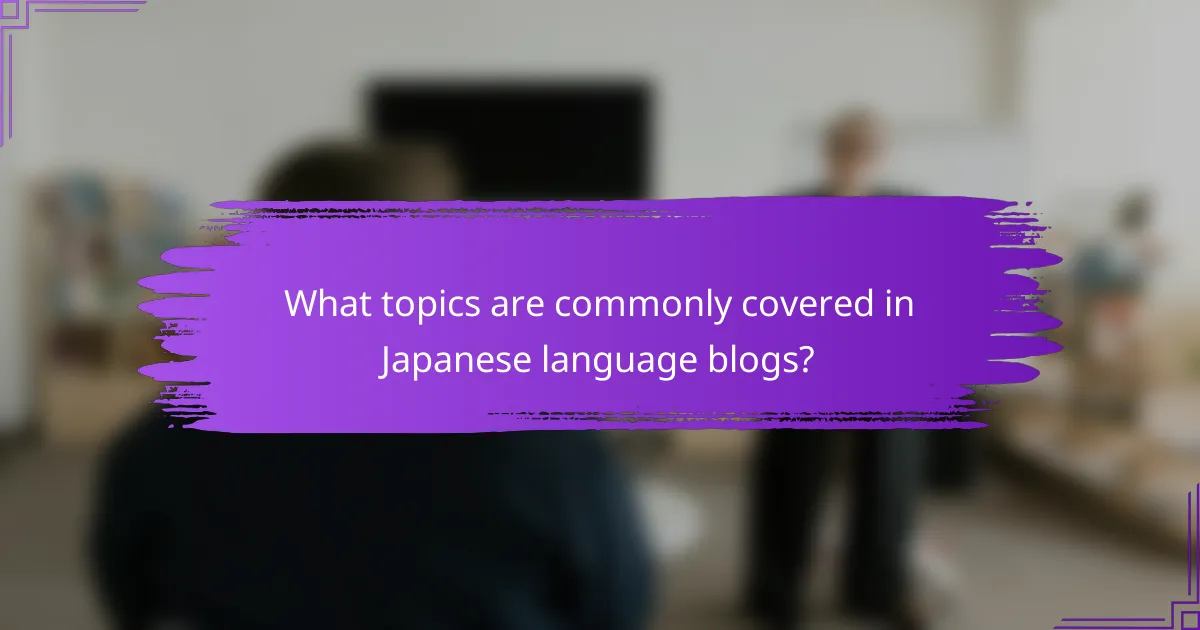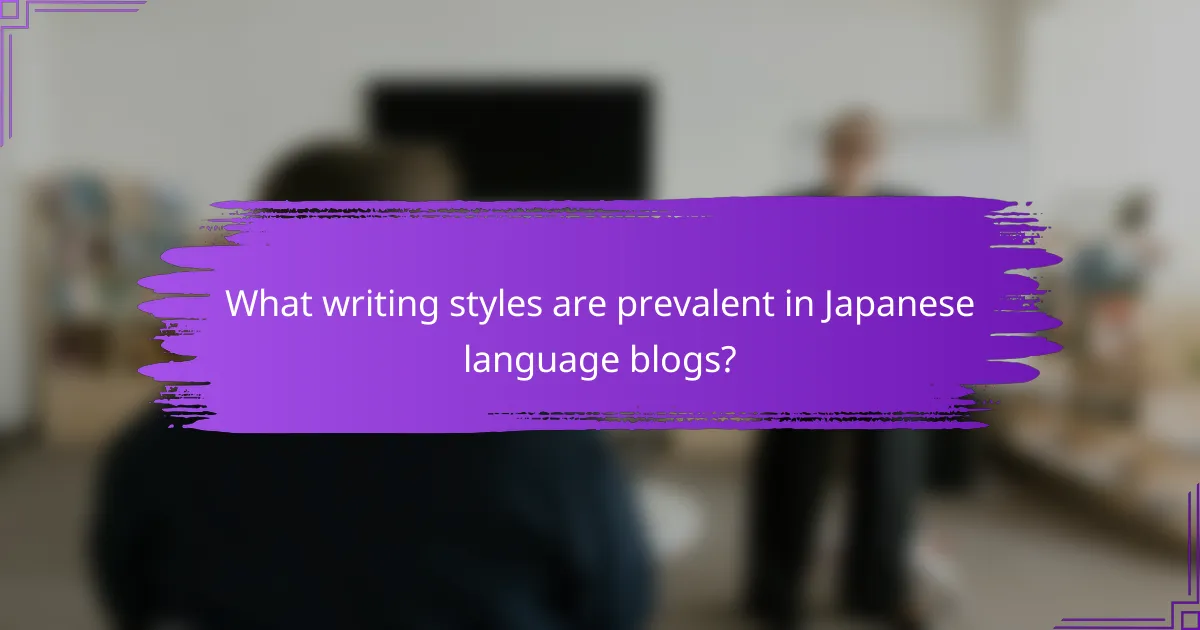
What are Japanese Language Blogs?
Japanese language blogs are online platforms where individuals write content primarily in Japanese. They cover a variety of topics, including culture, travel, food, and language learning. These blogs serve as resources for both native speakers and learners of the Japanese language. Many Japanese language blogs provide insights into everyday life in Japan. They often feature personal experiences and opinions, making them relatable to readers. Additionally, some blogs focus on teaching Japanese language skills. They may include grammar tips, vocabulary lists, and practice exercises. Blogs in this category can enhance cultural understanding and language proficiency.
How do Japanese language blogs differ from other language blogs?
Japanese language blogs differ from other language blogs primarily in their cultural context and audience engagement. These blogs often reflect unique aspects of Japanese culture, traditions, and societal norms. They may incorporate specific language nuances, idioms, and references that resonate with Japanese readers.
Additionally, Japanese blogs frequently focus on topics like anime, manga, and Japanese cuisine, which may not be as prevalent in blogs of other languages. The writing style tends to be more informal and personal, fostering a sense of community among readers.
Furthermore, Japanese bloggers often utilize platforms like Ameba and Hatena, which are less common in other linguistic contexts. This platform choice influences the format and style of content shared.
In terms of audience interaction, Japanese blogs may emphasize reader comments and feedback more than blogs in other languages. This engagement creates a more interactive experience for readers.
Overall, the combination of cultural relevance, topic focus, platform preference, and engagement style distinguishes Japanese language blogs from their counterparts in other languages.
What unique features do Japanese language blogs typically have?
Japanese language blogs typically feature a blend of personal storytelling and cultural insights. Many blogs include a focus on language learning tips and resources. They often utilize informal language and slang, making them relatable to readers. Visual elements like images and videos are frequently integrated to enhance engagement. Additionally, Japanese blogs may incorporate unique formatting styles, such as the use of emojis and colorful text. Many bloggers also engage with their audience through comments and social media. This interaction fosters a community feel among readers. Overall, these features contribute to the distinctiveness of Japanese language blogs.
How do cultural aspects influence the content of Japanese language blogs?
Cultural aspects significantly influence the content of Japanese language blogs. These blogs often reflect traditional values such as respect, harmony, and community. Writers incorporate culturally relevant themes, such as seasonal festivals and local customs. The language used in these blogs often includes honorifics and polite expressions, showcasing the importance of social hierarchy. Additionally, cultural references to popular media, like anime and manga, shape blog topics. The influence of Japanese aesthetics, such as minimalism and simplicity, can be observed in blog design and writing style. Furthermore, cultural attitudes towards education and self-improvement drive content focused on learning the language. Overall, cultural elements are deeply woven into the fabric of Japanese language blogs, shaping both their subject matter and presentation.
Why are Japanese language blogs important for learners?
Japanese language blogs are important for learners because they provide authentic language exposure. These blogs offer real-life examples of vocabulary and grammar in context. Learners can see how native speakers use the language in various topics. This exposure enhances reading comprehension and cultural understanding. Blogs often include informal language and slang not found in textbooks. Additionally, they can provide insights into current events and trends in Japan. Engaging with blogs helps learners practice their skills in a practical setting. This method supports language retention and fluency development.
What benefits do learners gain from reading Japanese language blogs?
Learners gain several benefits from reading Japanese language blogs. First, they improve their language skills through exposure to authentic content. Blogs often use casual, conversational Japanese, helping learners understand everyday language use. Second, learners expand their vocabulary by encountering new words and phrases in context. This contextual learning enhances retention and comprehension.
Third, reading blogs allows learners to engage with Japanese culture and current events. Many blogs cover topics like food, travel, and local customs, providing cultural insights. Additionally, learners can practice reading comprehension by tackling various writing styles and formats.
Blogs often include visuals, making the content more engaging and easier to understand. Finally, learners can connect with a community of like-minded individuals, fostering motivation and support in their language journey.
How can blogs enhance language acquisition and cultural understanding?
Blogs enhance language acquisition and cultural understanding by providing authentic language exposure and cultural insights. They offer real-world language use through articles, dialogues, and multimedia content. This exposure helps learners understand context, idiomatic expressions, and nuances in the target language.
Additionally, blogs often reflect cultural practices, traditions, and societal values. Readers gain insights into cultural contexts that shape language use. For example, a blog discussing Japanese festivals can illustrate related vocabulary and cultural significance.
Research shows that engaging with authentic materials increases language retention and comprehension. A study by the University of Michigan found that learners exposed to cultural content in language blogs improved their language skills and cultural awareness. Thus, blogs serve as valuable tools for both language learning and cultural immersion.

What topics are commonly covered in Japanese language blogs?
Japanese language blogs commonly cover topics such as language learning tips, cultural insights, travel experiences, and food reviews. Language learning tips include grammar explanations, vocabulary lists, and study techniques. Cultural insights often discuss traditional customs, festivals, and contemporary societal issues. Travel experiences provide recommendations for destinations in Japan, along with travel itineraries and tips. Food reviews highlight popular dishes, restaurant recommendations, and cooking recipes. These topics engage readers interested in improving their Japanese language skills and understanding Japanese culture better.
How do blog topics cater to different proficiency levels?
Blog topics cater to different proficiency levels by tailoring content complexity and vocabulary. Beginner-level topics often focus on basic grammar, vocabulary, and pronunciation. These topics use simple language and clear examples. Intermediate topics introduce more complex structures and cultural nuances. They may include conversational phrases and idiomatic expressions. Advanced topics explore intricate language aspects, such as advanced grammar and literature. They often require a deeper understanding of context and subtleties. This tiered approach helps learners engage at their respective levels. It also fosters progression by gradually increasing difficulty. Research shows that differentiated content enhances learner motivation and retention.
What beginner topics are popular among Japanese language learners?
Basic greetings are a popular beginner topic among Japanese language learners. Learners often start with simple phrases like “Konnichiwa” (Hello) and “Arigatou” (Thank you). Another common topic is numbers and counting. Understanding numbers is essential for everyday interactions. Vocabulary related to food and drink is also frequently studied. This includes words like “sushi” and “ocha” (tea). Additionally, learners focus on essential verbs such as “taberu” (to eat) and “nomu” (to drink). Basic grammar structures, like sentence formation, are important as well. Learners often explore particles like “wa” and “ga” to understand sentence roles. Simple conversational phrases are crucial for practical communication. These topics provide a foundational understanding of the language.
Which advanced topics challenge more experienced learners?
Advanced topics that challenge more experienced learners in Japanese include keigo (honorific language), idiomatic expressions, and complex grammar structures. Keigo requires a deep understanding of social hierarchies and context. Mastery of idiomatic expressions often involves cultural nuances that are not directly translatable. Complex grammar structures, such as conditional forms and passive voice, can be difficult to grasp. These topics require extensive practice and exposure to native usage. Research shows that learners struggle with these areas due to their abstract nature and contextual dependencies.
What role do current events play in Japanese language blogs?
Current events play a significant role in Japanese language blogs. These blogs often serve as platforms for discussing timely issues. Bloggers analyze and interpret news stories relevant to Japanese society. This engagement helps readers understand cultural contexts and societal reactions. Current events can drive traffic to blogs, as readers seek fresh perspectives. Many bloggers provide personal insights, making content relatable and engaging. Additionally, these discussions foster community dialogue among readers. Overall, current events enhance the relevance and dynamism of Japanese language blogs.
How do bloggers incorporate news and trends into their content?
Bloggers incorporate news and trends into their content by staying updated on current events and popular topics. They utilize social media platforms to monitor trending discussions. Many bloggers subscribe to industry newsletters for timely information. They also engage with their audience to understand interests and preferences. Incorporating timely topics boosts relevance and search engine visibility. For example, using trending hashtags can increase post engagement. Additionally, bloggers often create content that provides insights or opinions on recent developments. This approach fosters a connection with readers who seek current information.
What impact does this have on reader engagement and learning?
Japanese language blogs significantly enhance reader engagement and learning. They provide authentic content that resonates with learners. This authenticity fosters a deeper connection to the language and culture. Engaging writing styles keep readers interested and motivated. Interactive elements, such as quizzes and comments, encourage participation. Research shows that active engagement improves retention and understanding. A study by the University of Edinburgh found that interactive learning environments boost language acquisition rates by 30%. Thus, Japanese language blogs effectively combine engagement and educational value.

What writing styles are prevalent in Japanese language blogs?
Prevalent writing styles in Japanese language blogs include casual, informative, and narrative styles. Casual writing is characterized by a conversational tone. This style often uses colloquial language and personal anecdotes. Informative writing focuses on delivering factual content. It typically includes data, statistics, and clear explanations. Narrative writing tells stories or shares experiences. This style engages readers through personal or fictional narratives. These styles reflect the diverse interests of Japanese bloggers. They cater to various audiences, from casual readers to those seeking in-depth information.
How do writing styles vary among different bloggers?
Writing styles among different bloggers vary significantly based on their audience, purpose, and personal voice. Some bloggers adopt a formal tone to convey expertise, while others use a casual, conversational style to engage readers. Additionally, cultural influences play a role in shaping writing styles, especially in niche topics like Japanese language blogs. For instance, a blogger focusing on language learning may prioritize clarity and instructional elements. In contrast, a blogger sharing personal experiences might use storytelling techniques and humor. Research indicates that audience engagement often correlates with the blogger’s writing style, as seen in various studies on digital communication. This diversity in writing styles enhances the richness of content available to readers.
What are the characteristics of informal vs. formal writing in blogs?
Informal writing in blogs is characterized by a conversational tone and casual language. It often includes slang, personal anecdotes, and humor. This style engages readers and creates a sense of intimacy. In contrast, formal writing maintains a professional tone and uses precise language. It avoids colloquialisms and often adheres to grammatical conventions. Formal writing is typically structured, with clear arguments and evidence. Blogs that employ formal writing often aim to inform or educate. Informal writing fosters community and relatability, while formal writing establishes authority and credibility.
How do personal anecdotes enhance the learning experience in blogs?
Personal anecdotes enhance the learning experience in blogs by making content relatable and engaging. They provide real-life context that helps readers connect with the material. This connection can increase retention of information. Anecdotes often illustrate complex concepts in a simple way. They can evoke emotions, making the learning process more enjoyable. Research indicates that storytelling improves comprehension and recall. A study by the University of California found that narratives can boost memory retention by up to 65%. Therefore, personal anecdotes are effective tools in educational blogging.
What techniques do bloggers use to engage their audience?
Bloggers use various techniques to engage their audience effectively. They often employ storytelling to create relatable content. This method fosters emotional connections with readers. Additionally, bloggers use visuals such as images and videos to enhance their posts. Visual content captures attention and makes information more digestible.
Interactive elements like polls and quizzes are also common. These encourage reader participation and feedback. Bloggers frequently respond to comments, building a sense of community. Regular updates and consistent posting schedules keep audiences informed and returning for more.
Utilizing social media to share content broadens reach and engagement. Bloggers often collaborate with other creators to tap into new audiences. These techniques collectively enhance audience interaction and retention.
How do visuals and multimedia elements support blog content?
Visuals and multimedia elements enhance blog content by increasing engagement and comprehension. They attract readers’ attention and break up text, making the content more digestible. Research shows that articles with relevant images receive 94% more views. Additionally, videos can explain complex concepts more effectively than text alone. Infographics can summarize information succinctly, aiding retention. Visual elements also cater to different learning styles, appealing to visual learners. Overall, integrating visuals and multimedia fosters a more interactive and informative experience for readers.
What role does storytelling play in effective blog writing?
Storytelling plays a crucial role in effective blog writing by engaging readers and enhancing retention. It creates an emotional connection, making content more relatable. Engaged readers are more likely to share the content, increasing reach. Research indicates that stories improve information recall by 22 times compared to facts alone. This is due to the brain’s natural inclination to respond to narratives. Furthermore, storytelling can simplify complex ideas, making them accessible. In the context of Japanese language blogs, personal anecdotes can illustrate cultural nuances effectively. Overall, storytelling enriches the reading experience and fosters a deeper understanding of the subject matter.
What are some best practices for reading and writing Japanese language blogs?
Best practices for reading and writing Japanese language blogs include understanding cultural context and language nuances. Readers should familiarize themselves with common expressions and idiomatic phrases. This enhances comprehension and engagement with the content. Writers should focus on clarity and simplicity in their language. Using straightforward vocabulary helps reach a broader audience. Incorporating visuals can also enhance understanding and retention. Additionally, engaging with readers through comments fosters community interaction. Regular updates to content keep the audience informed and interested. Finally, proofreading for grammar and spelling is essential for professionalism. These practices ensure effective communication in the Japanese blogging space.
How can learners effectively utilize blogs for language practice?
Learners can effectively utilize blogs for language practice by engaging with content written in the target language. Reading blogs helps improve vocabulary and comprehension skills. Writing comments or responses on these blogs allows learners to practice their writing skills. Additionally, learners can start their own blogs to express thoughts in the target language. This practice encourages regular writing and self-expression. Following blogs that focus on specific interests can enhance motivation and retention. Engaging with the blog community fosters interaction with native speakers and other learners. Research shows that consistent exposure to authentic language use significantly aids language acquisition.
What tips can bloggers follow to create engaging and educational content?
Bloggers can create engaging and educational content by focusing on clarity, relevance, and audience engagement. They should use simple language to ensure understanding. Incorporating visuals can enhance comprehension and retention. Providing real-life examples makes concepts relatable. Bloggers should also encourage interaction through questions or comments. Regular updates keep content fresh and relevant. Utilizing SEO strategies increases visibility and reach. Lastly, sharing personal experiences adds authenticity and connection with readers.
Japanese language blogs are online platforms where content is primarily written in Japanese, covering topics such as culture, travel, food, and language learning. These blogs serve as valuable resources for both native speakers and learners, offering insights into everyday life in Japan and practical language tips. The article explores the unique characteristics of Japanese language blogs, including their cultural influences, writing styles, and the benefits they provide to language learners. Additionally, it discusses common topics, audience engagement techniques, and best practices for both reading and writing in this niche.